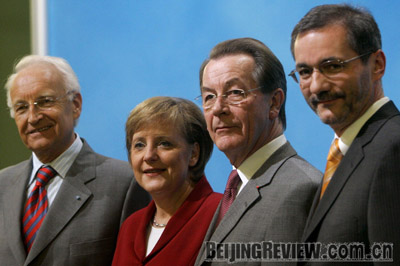|
|

|
|
GRAND COALITION: German Chancellor Angela Merkel (second from left) poses with Christian Social Union Chairman Edmund Stoiber (left), Social Democratic Party Chairman Franz Müntefering (second from right) and Matthias Platzeck (right), President of the Bundestag, the upper house of the German parliament, shortly before taking office in November 2005 |
Three decades ago, the SPD had 1 million members, while the CDU/CSU had 800,000. Statistics at the end of June 2008 showed that SPD members totaled less than 500,000, while the CDU/CSU had slightly more members than the SPD. Today, many young Germans do not consistently support one single party. They often make choices based on different parties' election platforms, a trend that has resulted in continued decline in the two major parties' influence. An opinion poll in July showed that the approval ratings of the CDU/CSU and the SPD stood at 36 percent and 25 percent, respectively, according to the German TV broadcaster ARD.
Given the changes in Germany since the end of World War II, the differences between the CDU/CSU and the SPD-the former at the right wing and the latter at the left wing-have blurred. In 2003, the then-ruling SPD formulated Agenda 2010. The agenda suggested cutting the Germans' high social security benefits in light of economic globalization and Germany's stagnant economy and shrinking population. It proved unpopular with most employees. As a result, the SPD lost elections to the CDU/CSU in industrial zones with large worker populations such as Ruhr.
After the reunification of Germany, the CDU/CSU encountered a series of difficulties in rejuvenating the economy of the former East Germany, dashing local people's hopes of enjoying the same living standards as their West German counterparts. Its approval rating dropped to 35 percent before the 1998 federal election, while the approval rating of the SPD climbed to 40.9 percent. In this context, the CDU/CSU was forced to finetune its policies leftward to canvass support from voters. Not long ago, Chancellor Angela Merkel called for the establishment of more kindergartens. The proposal is a marked departure from her conservative party's traditional family policy. While human rights were once the exclusive domain of the SPD and the Greens, the CDU/CSU now also embraces a value-oriented approach and human rights.
New forces
The Greens rose to prominence in 1979 when large protests broke out against NATO's decision to deploy strategic nuclear missiles in West Germany. In 1983, they formed a coalition government with the SPD in Hesse. It was the first time the party was represented in a German state government. In 1998, it formed a federal coalition government with the SPD.
In the past, the CDU/CSU would not make any political compromises with the Greens. Things have changed in recent years. The two parties have formed a number of coalition governments at the local level, such as in Frankfurt and Hamburg State. The black-green coalition formed in Hamburg this year is the very first such coalition at the state level in Germany. Both parties compromised while negotiating the coalition and the Greens succeeded in having a bicycle lane built downtown Hamburg. Merkel recently said the CDU/CSU would seek to ally with the Greens and the FDP after the 2009 federal election, instead of continuing to form a grand coalition government with the SPD.
After the Greens made it clear they were prepared to ally with either the CDU/CSU or the SPD, the FDP, which has allied only with the CDU/CSU in recent years, had to change its policy as well. While the Greens cozied up to the CDU/CSU, the FDP has said it would not reject an alliance with the SPD.
|
